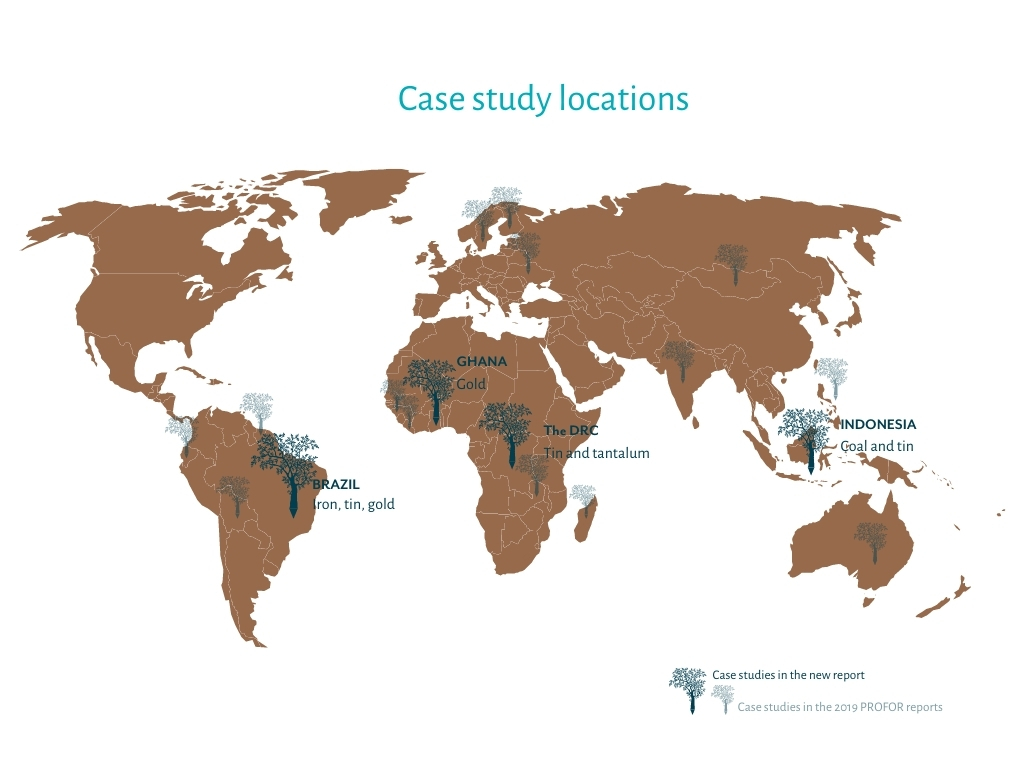Minerals and metals are fundamental to contemporary life; our ways of life cannot be substantially ‘demineralized’ without curtailing the boundaries of humanity’s potential, and the transition to a green economy depends on continued mining for commodities such as copper, iron ore, lithium, cobalt and graphite. But mining and its associated infrastructure impact forests in multiple and profound ways, often having negative impacts on biodiversity and the ecosystem services provided by forest landscapes, eroding ecological health and human rights.
Deforestation is responsible for 15-30% of GHG emissions and is one of the most important battlegrounds in the fight against climate change, species collapse and human rights. Mining is the fourth-largest driver of deforestation globally, causing about 7% of deforestation in tropical and sub-tropical countries. The number of large-scale mines commissioned in forest areas has increased. 10% of forests are influenced by operational mines, rising to 30% if including those in development or closed.
The nature and extent of these impacts necessitate approaches to mining that avoid, minimize and restore damage to forests, forest landscapes and forest peoples – an approach that is ‘forest-smart’.
Today Levin Sources and Fauna & Flora International are proud to release our latest report, How to bring about forest-smart mining: strategic entry points for institutional donors. With actions identified for host governments, markets, investors, standard setters, and civil society our report is intended to present a menu of programming options for donors interested in the mining sector’s relationship to climate change, biodiversity, human rights, and the UN Sustainable Development Goals.
The time to act is now. The Amazon is approaching a tipping point; the UN Decade on Restoration begins in 2021; indigenous peoples are finally achieving greater attention as stewards of land and natural resources; there is momentum in the wilding movement; David Attenborough has called for $500 billion to be invested in nature; and President-elect Joe Biden has made significant commitments to tackling climate change as an urgent priority for his and Kamala Harris’ administration.
Interested? Get in touch if you’d like to know more about promoting forest-smart mining (FSM).
Key report highlights
- The report provides a strategic analysis of the principal initiatives and stakeholders working to address the negative impacts of mining and their relevance to the protection of forests and forest peoples. It documents a complicated landscape of stakeholders, drivers and policy levers which offer entry points for making mining forest-smart.
- It explores and details the various policy and institutional challenges and opportunities related to FSM, such as sustainable finance, supply chain due diligence and responsible sourcing, human rights, good governance, transparency and accountability, standard setting. It details the urgent need to improve data collection and monitoring of mining’s impacts on forests including the development of mining surveillance technology and associated guidance; and the need for a fund to orient sustainable finance towards forest smart mining.
- It presents a logical framework for interventions according to the stage of the mining life cycle, countries, minerals, economic sectors, scales, companies, type of mining, mining methods, nature-based solutions and carbon finance, and institution type.
- It proposes first actions different actors can take – and donors could catalyse – to make mining more forest-smart. Priority development interventions are support for anti-corruption, civil society scrutiny and capacity building, protection of environmental defenders, prioritising local natural resource governance by indigenous peoples and local communities, support for and coordination with multilateral initiatives like the World Bank’s Climate Smart Mining Initiative and the UN Decade of Restoration, and coordinating with multilateral institutions like the OECD and the Intergovernmental Forum for Mining and Metals.
- Finally, it explores and details knowledge gaps that necessitate attention, especially on the forest impacts of coal and development/construction minerals, the elevation of indigenous peoples’ rights, what good restoration looks like, the business case for nature-based solutions in mining landscapes, and how climate action in the mining sector can support climate change mitigation and the objectives of REDD+.
- Specific country case studies explored in greater detail are:
- Iron, tin, gold in Brazil
- Gold in Ghana
- Coal and tin in Indonesia
- Tin and tantalum in DRC
Additional case studies in Australia, Bolivia, Brazil, Colombia, Democratic Republic of Congo, Ecuador, Finland, Ghana, Guinea, India, Indonesia, Liberia, Madagascar, Mongolia, the Philippines, Suriname, Sweden, Ukraine, and Zambia can be found in the original reports for the World Bank.

What can you do to advance FSM?
Your spheres of influence will typically be your own policies, operations and investments, as well as the leverage you can exert over others in your supply chains and the policy arena, including your competitors. Levin Sources helps clients make change in each of these domains across a suite of issues, including forest-smart mining. Get in touch if you want to do more and either don’t know where to start, or want some specific support, such as with carbon accounting and management, environmental due diligence, or designing a forest-smart approach to your business.
- Work by Levin Sources and FFI in Forest-Smart Mining:
-
- 2017 - 2019 – WB FSM ASM project, WB FSM LSM project, WB FSM Exec Summ.
- 2018 – panel at IGF in Geneva, NYDF side event to UNGA in Washington D.C.
- 2019 – launch of WB reports at Chatham House
- 2020 – Chatham house report was published on the back of the launch of our World Bank reports.
- 29th October 2020 – NYDF GLF Biodiversity Panel
- 05 November 2020 – FCPF panel
- 10th November 2020 – RMF panel
- 03 December 2020 – Natural History Museum / EU InFact Mining and Society conference
- Our Volunteering
-
- In addition to our status as signatories to the New York Declaration on Forests, Levin Sources and FFI are NYDF Assessment Partners and members of the NYDF Refresh process
- FFI sits on the Board of ResponsibleSteel and the Aluminium Stewardship Initiative
- Levin Sources is a member of the Responsible Steel Greenhouse Gas Working Group
- Levin Sources is a member of the Global Battery Alliance Battery Passport Greenhouse Gas Working Group
- Report authors and acknowledgements
-
This report was written by Estelle Levin-Nally, Samir Whitaker and Blanca Racionero-Gomez.
Case studies were written by Sebastien Pennes (DRC), Bernardo Ranieri (Brazil), João Guimarães (Brazil), Samir Whitaker (Indonesia), Blanca Racionero-Gomez (Indonesia and Ghana), Andrew Cauldwell (Ghana), with editorial oversight by Estelle Levin-Nally. Additional contributions from Adam Rolfe and Angela Jorns.
Peer review by Holger Grundel (Levin Sources), Pippa Howard and Thomas Maddox (FFI), John Drexhage (the World Bank), Kirsten Hund, and Mark Freudenberger (Tetra Tech). Editing by Chloe Jacot, Nick Wolff and Olivia Lyster.
- The Origins of ‘Forest-Smart Mining’
-
The World Bank developed the concept of Forest-Smart Mining in 2017 to raise awareness of different economic sectors’ impacts upon forest health and forest values, such as biodiversity, ecosystem services, human development, supporting and regulating services and cultural values.
From 2017 to 2019, Levin Sources, Fauna and Flora International, Swedish Geological AB, and Fairfields Consulting were commissioned by the World Bank to investigate good and bad practices of all scales of mining in forest landscapes, and the contextual conditions that support ‘forest-smart’ mining.
Three reports and an Executive Summary were published in May 2019, further to a series of events and launches in New York, Geneva, and London which have led to related publications. How to bring about forest-smart mining: strategic entry points for institutional donors builds upon the understanding this report generated to propose concrete actions because action is urgent and the time to act is now.



